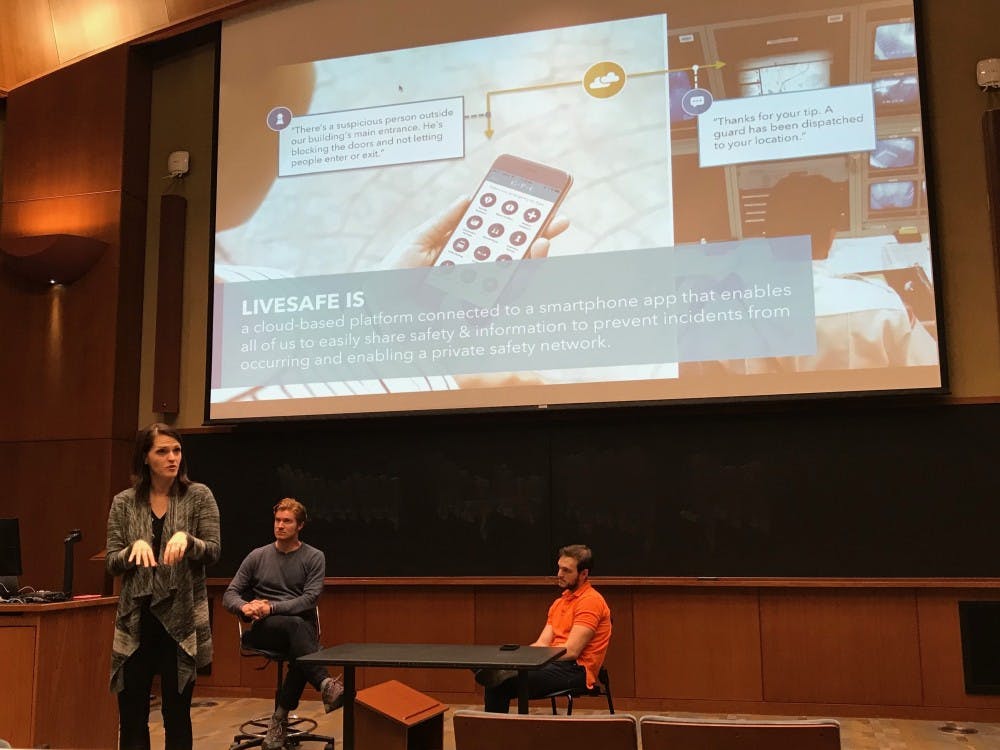The University Police Department held a live demo of “LiveSafe,” a potential addition to the University’s emergency communication system, in Nau Hall Tuesday evening. The event was co-hosted by the Minority Rights Coalition, Student Council and the Honor Committee.
The University currently communicates emergency information through U.Va Alerts, which informs faculty, staff and students registered for the notifications about hazardous situations through a brief text.
Evelyn Wang, a fourth-year Commerce student and chair of the Minority Rights Coalition, said the current U.Va Alerts system was criticized by some students after the events of Aug. 11.
“If [Lawn residents] had received an alert that there were a hundred people here with torches, they wouldn’t have left their rooms,” Wang said. “But since they received no alert, they assumed it was no big deal. And that obviously disproportionately affects minority students. University policing in general disproportionately affects minority students.”
Following these complaints and broader concerns about emergency preparedness after the events of Aug. 11 and 12, Student Council’s committee on Safety and Wellness formed a committee on emergency preparedness, inviting representatives from the MRC and Honor Committee to work with the University Police Department and the University’s Office for Safety and Emergency Preparedness.
Tuesday’s demonstration heard student feedback about introducing LiveSafe, a mobile safety communications platform.
Unlike U.Va. Alerts, “LiveSafe” includes interactive functions, such as “Report Tips,” which allows students, faculty and staff to provide information about suspicious behavior and safety concerns they see on Grounds.
LiveSafe also provides geofencing, which sends out alerts only to users in an affected area. The platform has already been implemented in over 140 colleges and universities.
Anne Cynamon, national director for higher education solutions at LiveSafe, said the motivation for founding the company came after the 2007 mass shooting at Virginia Tech.
“One of our co-founders, Kristina Anderson, was the most critically injured survivors of [the attack],” Cynamon said. “She has since now dedicated herself to campus safety in general, very much focused on the power of prevention and how can we get ahead of some of these issues we keep hearing about and reading about.”
Cynamon said students must engage with the system for it to be successful. LiveSafe wants students to share information through its features.
“We have the ability to embed [within] existing apps you have in your University community, so you can submit a tip while you’re within other applications,” Cynamon said.
Students can use LiveSafe features while using applications such as UVA Health and Transloc Rider
However, Wang said she has concerns on the administration’s execution and implementation of LiveSafe. She said the new system may not be effective unless it becomes mandatory for students to download it.
“My fear is that the University would spend all this money on LiveSafe and then not use it well, not respond to tips efficiently, that it’s not well-staffed, that the right resources aren’t on the U.Va.-specific app,” Wang said.
In an interview, Brandt Welch, a fourth-year Engineering student and the Honor Committee’s vice chair for community relations, said Resident Advisors could make sure their residents download the app when they move in.
LiveSafe representative and University alumnus Dan Morrison said that the application did not need to have wide community engagement to be a worthwhile investment.
“In my mind if it prevents one person from being kidnapped, one person from committing suicide, one person from being raped, then it doesn’t matter if you have 8,000 people downloading it,” he said.
The University has not yet committed to moving forward with “LiveSafe.”







